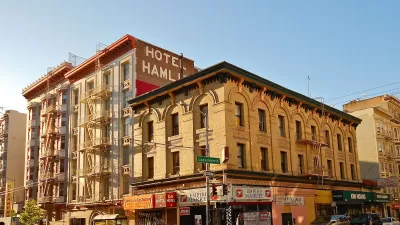With COVID-19 assistance programs expiring, tenants of the city’s single-room occupancy hotels face growing eviction rates. Many of them have nowhere to go but back on the street.

Residents of San Francisco’s single-room occupancy hotels (SROs), many of whom depend on the city-funded housing to stay out of homelessness, are getting evicted at higher rates as pandemic-era assistance programs lapse, report Joaquin Palomino and Trisha Thadani of the San Francisco Chronicle. According to the article, at least 114 people were evicted in the last fiscal year, compared to 40 in the previous years. “The Chronicle found that more than half of all evictions were in nine residential hotels, which housed 16% of all supportive housing SRO residents.”
The authors point out that these numbers belie the true extent of the city’s housing crisis, and that many tenants are forced out through unofficial means not recorded by HSH. “For example, some residents sign agreements with property managers, promising to leave by a certain date in order to keep the eviction off the books and preserve their housing record.”
The authors note that “The nonprofits that contract with the Department of Homelessness and Supportive Housing (HSH) to manage SROs typically kick out residents for the same issues that qualified them for the supportive housing programs in the first place: poverty, mental illness, trauma or an inability to care for themselves.” The Chronicle’s investigation found that these residents rarely receive any support in finding new housing.

Study: Maui’s Plan to Convert Vacation Rentals to Long-Term Housing Could Cause Nearly $1 Billion Economic Loss
The plan would reduce visitor accommodation by 25,% resulting in 1,900 jobs lost.

North Texas Transit Leaders Tout Benefits of TOD for Growing Region
At a summit focused on transit-oriented development, policymakers discussed how North Texas’ expanded light rail system can serve as a tool for economic growth.

Why Should We Subsidize Public Transportation?
Many public transit agencies face financial stress due to rising costs, declining fare revenue, and declining subsidies. Transit advocates must provide a strong business case for increasing public transit funding.

How to Make US Trains Faster
Changes to boarding platforms and a switch to electric trains could improve U.S. passenger rail service without the added cost of high-speed rail.

Columbia’s Revitalized ‘Loop’ Is a Hub for Local Entrepreneurs
A focus on small businesses is helping a commercial corridor in Columbia, Missouri thrive.

Invasive Insect Threatens Minnesota’s Ash Forests
The Emerald Ash Borer is a rapidly spreading invasive pest threatening Minnesota’s ash trees, and homeowners are encouraged to plant diverse replacement species, avoid moving ash firewood, and monitor for signs of infestation.
Urban Design for Planners 1: Software Tools
This six-course series explores essential urban design concepts using open source software and equips planners with the tools they need to participate fully in the urban design process.
Planning for Universal Design
Learn the tools for implementing Universal Design in planning regulations.
City of Santa Clarita
Ascent Environmental
Institute for Housing and Urban Development Studies (IHS)
City of Grandview
Harvard GSD Executive Education
Toledo-Lucas County Plan Commissions
Salt Lake City
NYU Wagner Graduate School of Public Service





























